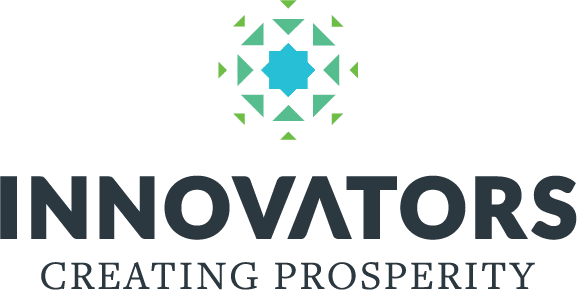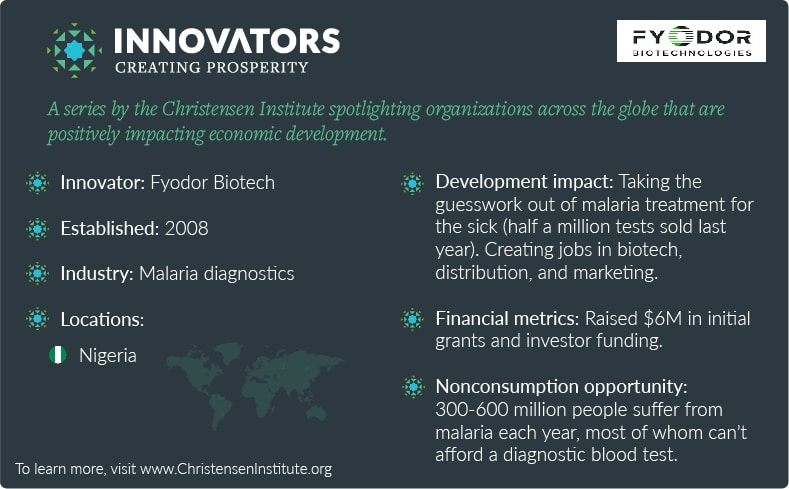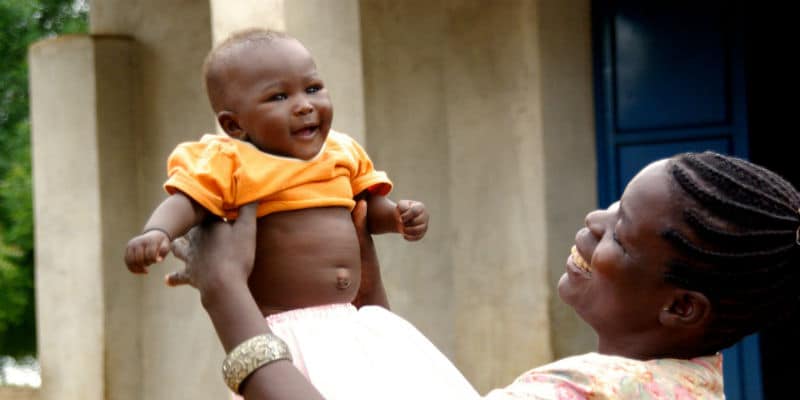Welcome to our Innovators Creating Prosperity series, spotlighting organizations across the globe that are positively impacting economic development.

I awoke to what felt like lightning going through my legs, and then spreading through my body and in my head. Probably the worst headache, body aches, and chills you could possibly imagine. It felt like I was being stung repeatedly by an electric shock gun and could barely control my movements. The pain was so intense; I believed I was dying.
This harrowing description is how one person described their experience with malaria, a disease that still kills more than 420,000 people annually, 92% of whom are in Africa.
Over the past couple of decades the development industry has made strides in combating the deadly disease, yet one challenge stubbornly persists: tests for malaria must be administered by certified healthcare workers, making them prohibitively expensive for those who contract it. With more than 212 million cases annually, the disease is so common that whenever most Africans develop a fever, they automatically treat it as malaria to avoid enduring expensive and complicated blood tests. This can result in adverse public health implications when people misdiagnose their illness; not only are patients not cured of the illness that’s actually making them sick, but malaria drugs on the market also begin to lose their effect as people develop a resistance to them.
This is where Fyodor Biotechnologies comes into the picture. Dr. Eddy Agbo and his team have developed the Urine Malaria Test (UMT)—an inexpensive malaria diagnostic solution. For less than two dollars, a patient can purchase a UMT that will easily diagnose whether or not their fever is malaria in under 25 minutes.
In the past year since the UMT has been on the market, it’s already achieved impressive results. Fyodor has sold half a million tests in Nigeria, enabling more people to treat their illnesses properly without incurring significant financial setbacks. The biotech company has begun distributing tests to other countries in sub-Saharan Africa as well, and has raised more than $6 million in initial funding to bring the UMT to market. We sat down with Dr. Eddy Agbo to understand how he developed this idea and the early struggles and successes his company has experienced.
1. Where did you get your idea? How did you know there was opportunity?
As a postdoctoral fellow in infectious diseases at Johns Hopkins, I spent a lot of time in the lab learning about potentially viable solutions to many diseases in low- and middle-income countries. But most solutions weren’t funded beyond lab experiments because they weren’t seen as commercially viable. Somehow, I thought that if we could make some of these solutions more affordable, especially in the area of deadly diseases such as malaria, there could be significant opportunity. It was then I decided to turn in my lab coat and go the entrepreneurial route to tackle malaria diagnostics.
Theory insight: This isn’t uncommon when markets haven’t yet been created for products or services. What Dr. Agbo describes represents the general unwillingness to create a new market by tackling nonconsumption—when people are literally unable to “consume” something because it’s too expensive, complicated, or inaccessible. But as Dr. Agbo discovered, that unwillingness is actually shortsighted and can represent significant opportunity.
2. What was your initial target market?
Our initial target market was the 87 million people living in extreme poverty in Nigeria and the tens of millions of others in the country for whom accessible malaria diagnostics solutions are also unavailable. We plan further expansion to a shortlist of countries in sub-Saharan Africa and Asia, where malaria is most prevalent.
3. What did your target market do/use before your innovation was available?
The majority of people in these markets either self-diagnose most fevers as malaria or, if they can afford it, travel to the closest clinic to get a blood test. This is highly inconvenient and expensive for most people in Nigeria and other markets we plan to pursue.
Theory insight: Workarounds—like self-diagnosis—and complex solutions that most people in a region cannot afford are a good sign that there’s a significant opportunity to create a market.
4. Where did you raise funding, and what advice would you give others regarding fundraising?
Our funding came from a mixture of grants and equity investments from angel investors, including some financing from friends and family.
Theory insight: We have found that at the market-creation phase, most entrepreneurs have a difficult time raising funds from many conventional investors, such as venture capital, private equity, and hedge funds. A better path during this phase is often to tap into their personal networks.
5. Innovators often feel that the lack of an enabling environment in emerging markets—poor infrastructure, inadequate institutions, and little government support—is insurmountable. How did you overcome these challenges?
Depending on what entrepreneurs ask of governments, they can sometimes be helpful. In our case, Nigeria’s Federal Ministry of Health supported and participated in the pivotal clinical trial that validated the UMT.
Our biggest challenge has been changing the cultural norm in which most fevers are immediately treated as malaria. We are addressing commonly held norms by engaging in Behavioral Change communication through our outreach programs and digital marketing campaign, creating awareness and educating the masses on the disadvantages of treating without testing, and posting engaging graphics and content on social media. We are closely engaged with Proprietary Patent Medicine Vendors (PPMVs) who mostly address rural patients, partnering with them to encourage testing before treatment through subsidized UMT and free sample offerings.
Theory insight: Entrepreneurs must never underestimate the value in educating future consumers about their product, especially in the market-creating phase. Because people have learned to live without the product, largely by engaging in workarounds, educating consumers is key to making the product successful.
6. What can other innovators take away from your experience? Is there anything you’d do differently?
If I’d do it again, I’d start ten years earlier! There have been many ups and downs in this journey; for an entrepreneur to successfully introduce a new product, perseverance is key.




